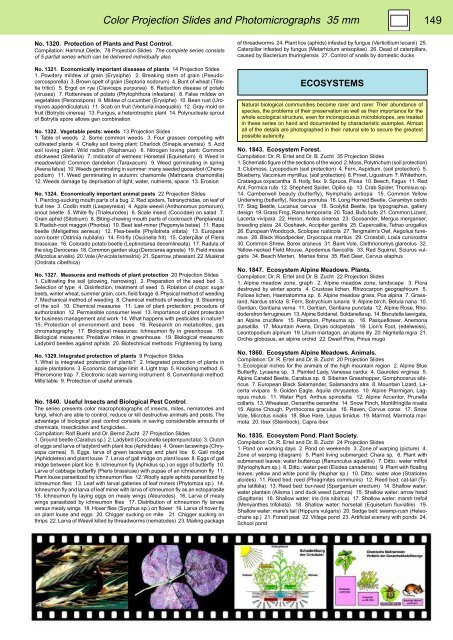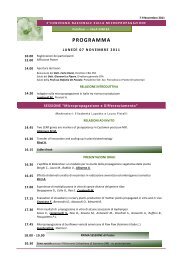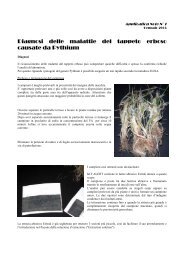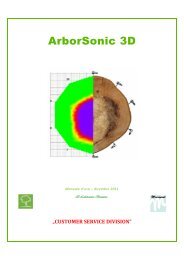BIOLOGY - microscopia.info
BIOLOGY - microscopia.info
BIOLOGY - microscopia.info
Create successful ePaper yourself
Turn your PDF publications into a flip-book with our unique Google optimized e-Paper software.
Color Projection Slides and Photomicrographs 35 mm 149<br />
No. 1320. Protection of Plants and Pest Control.<br />
Compilation: Hartmut Dietle, 78 Projection Slides The complete series consists<br />
of 5 partial series which can be delivered individually also.<br />
No. 1321. Economically important diseases of plants 14 Projection Slides<br />
1. Powdery mildew of grain (Erysiphe) 2. Breaking stem of grain (Pseudocercosporella)<br />
3. Brown spelt of grain (Septoria nodorum) 4. Bunt of wheat (Tilletia<br />
tritici) 5. Ergot on rye (Claviceps purpurea) 6. Reduction disease of potato<br />
(viruses) 7. Rottenness of potato (Phytophthora infestans) 8. False mildew on<br />
vegetables (Peronospora) 9. Mildew of cucumber (Erysiphe) 10. Bean rust (Uromyces<br />
appendiculatus) 11. Scab on fruit (Venturia inaequalis) 12. Gray mold on<br />
fruit (Botrytis cinerea) 13. Fungus, a heterotrophic plant 14. Polynucleate sprout<br />
of Botrytis spore allows gen combination<br />
No. 1322. Vegetable pests: weeds 13 Projection Slides<br />
1. Table of weeds 2. Some common weeds 3. Four grasses competing with<br />
cultivated plants 4. Chalky soil loving plant: Charlock (Sinapis arvensis) 5. Acid<br />
soil loving plant: Wild radish (Raphanus) 6. Nitrogen loving plant: Common<br />
chickweed (Stellaria) 7. Indicator of wetness: Horsetail (Equisetum) 8. Weed in<br />
meadowland: Common dandelion (Taraxacum) 9. Weed germinating in spring<br />
(Avena fatua) 10. Weeds germinating in summer: many seeded goosefoot (Chenopodium)<br />
11. Weed germinating in autumn: chamomile (Matricaria chamomilla)<br />
12. Weeds damage by deprivation of light, water, nutrients, space 13. Erosion<br />
No. 1324. Economically important animal pests 22 Projection Slides<br />
1. Piercing-sucking mouth parts of a bug 2. Red spiders, Tetranychidae, on leaf of<br />
fruit tree 3. Codlin moth (Laspeyresia) 4. Apple weevil (Anthonomus pomorum),<br />
snout beetle 5. White fly (Trialeurodes) 6. Scale insect (Coccidae) on salad 7.<br />
Grain aphid (Sitobium) 8. Biting-chewing mouth parts of cockroach (Periplaneta)<br />
9. Radish-root maggot (Phorbia) 10. Beet leaf-miner (Pegomyia betae) 11. Rape<br />
beetle (Meligethes aeneus) 12. Flea-beetle (Phyllotreta vittata) 13. European<br />
corn-borer (Ostrinia nubilalis) 14. Frit-fly (Oscinella frit) 15. Caterpillar of Pieris<br />
brassicae 16. Colorado potato beetle (Leptinotarsa decemlineata) 17. Radula of<br />
the slug Deroceras 18. Common garden slug (Deroceras agreste) 19. Field mouse<br />
(Microtus arvalis) 20. Vole (Arvicola terrestris) 21. Sparrow, pheasant 22. Muskrat<br />
(Ondrata cibethica)<br />
No. 1327. Measures and methods of plant protection 20 Projection Slides<br />
1. Cultivating the soil (plowing, harrowing) 2. Preparation of the seed bed 3.<br />
Selection of type 4. Disinfection, treatment of seed 5. Rotation of crops: sugar<br />
beets, winter wheat, summer grain, corn, field forage 6. Physical method of weeding<br />
7. Mechanical method of weeding 8. Chemical methods of weeding 9. Steaming<br />
of the soil 10. Chemical measures 11. Law of plant protection; procedure of<br />
authorization 12. Permissible consumer level 13. Importance of plant protection<br />
for business management and work 14. What happens with pesticides in nature?<br />
15. Protection of environment and bees 16. Research on metabolites, gas<br />
chromatography 17. Biological measures: Ichneumon fly in greenhouse 18.<br />
Biological measures: Predative mites in greenhouse 19. Biological measures:<br />
Ladybird beetles against aphids 20. Biotechnical methods: Frightening by bang<br />
No. 1329. Integrated protection of plants 9 Projection Slides<br />
1. What is integrated protection of plants? 2. Integrated protection of plants in<br />
apple plantations 3. Economic damage limit 4. Light trap 5. Knocking method 6.<br />
Pheromone trap 7. Electronic scab warning instrument 8. Conventional method:<br />
Mills’table 9. Protection of useful animals<br />
No. 1840. Useful Insects and Biological Pest Control.<br />
The series presents color macrophotographs of insects, mites, nematodes and<br />
fungi, which are able to control, reduce or kill destructive animals and pests. The<br />
advantage of biological pest control consists in saving considerable amounts of<br />
chemicals, insecticides and fungicides..<br />
Compilation: Rolf Buehl and Dr. Bernd Zucht 27 Projection Slides<br />
1. Ground beetle (Carabus sp.) 2. Ladybird (Coccinella septempunctata) 3. Clutch<br />
of eggs and larva of ladybird with plant lice (Aphididae) 4. Green lacewings (Chrysopa<br />
carnea) 5. Eggs, larva of green lacewings and plant lice 6. Gall midge<br />
(Aphidoletes) and plant louse 7. Larva of gall midge on plant louse 8. Eggs of gall<br />
midge between plant lice 9. Ichneumon fly (Aphidius sp.) on eggs of butterfly 10.<br />
Larva of cabbage butterfly (Pieris brassicae) with pupae of an ichneumon fly 11.<br />
Plant louse parasitized by ichneumon flies 12. Woolly apple aphids parasitized by<br />
ichneumon flies 13. Leaf with larval galleries of leaf miners (Phytomiza sp.) 14.<br />
Ichneumon fly and larva of leaf miner with larva of ichneumon fly as an ectoparasite<br />
15. Ichneumon fly laying eggs on mealy wings (Aleurodes) 16. Larva of mealy<br />
wings parasitized by ichneumon flies 17. Distribution of ichneumon fly larvae<br />
versus mealy wings 18. Hover flies (Syrphus sp.) on flower 19. Larva of hover fly<br />
on plant louse and eggs 20. Chigger sucking on mite 21. Chigger sucking on<br />
thrips 22. Larva of Weevil killed by threadworms (nematodes) 23. Mailing package<br />
of threadworms 24. Plant lice (aphids) infested by fungus (Verticillium lecanii) 25.<br />
Caterpillar infested by fungus (Metarhizium anisopliae) 26. Dead of caterpillars,<br />
caused by Bacterium thuringiensis 27. Control of snails by domestic ducks<br />
ECOSYSTEMS<br />
Natural biological communities become rarer and rarer. Their abundance of<br />
species, the problems of their preservation as well as their importance for the<br />
whole ecological structure, even for inconspicuous microbiotopes, are treated<br />
in these series on hand and documented by characteristic examples. Almost<br />
all of the details are photographed in their natural site to secure the greatest<br />
possible autencity.<br />
No. 1843. Ecosystem Forest.<br />
Compilation: Dr. R. Ertel and Dr. B. Zucht 35 Projection Slides<br />
1. Schematic figure of the sections of the wood 2. Moss, Polytrichum (soil protection)<br />
3. Clubmoss, Lycopodium (soil protection) 4. Fern, Aspidium, (soil protection) 5.<br />
Blueberry, Vaccinium myrtillus, (soil protection) 6. Privet, Ligustrum 7. Whitethorn,<br />
Crataegus oxyacantha 8. Holly, Ilex 9. Spruce, Picea 10. Beech, Fagus 11. Red<br />
Ant, Formica rufa 12. Shepherd Spider, Opilio sp. 13. Crab Spider, Thomisus sp.<br />
14. Camberwell beauty (butterfly), Nymphalis antiopa 15. Common Yellow<br />
Underwing (butterfly), Noctua pronuba 16. Long Horned Beetle, Cerambyx cerdo<br />
17. Stag Beetle, Lucanus cervus 18. Scolytid Beetle, Ips typographus, gallery<br />
design 19. Grass Frog, Rana temporaria 20. Toad, Bufo bufo 21. Common Lizard,<br />
Lacerta vivipara 22. Heron, Ardea cinerea 23. Goosander, Mergus merganser,<br />
breeding place 24. Goshawk, Accipiter gentilis 25. Capercaillie, Tetrao urogallus<br />
26. European Woodcock, Scolopax rusticola 27. Tengmalm’s Owl, Aegolius funereus<br />
28. Black Woodpecker, Dryocopus martius 29. Crossbill, Loxia curvirostra<br />
30. Common Shrew, Sorex araneus 31. Bank Vole, Clethrionomys glareolus 32.<br />
Yellow-necked Field Mouse, Apodemus flavicollis 33. Red Squirrel, Sciurus vulgaris<br />
34. Beach Marten, Martes foina 35. Red Deer, Cervus elaphus<br />
No. 1847. Ecosystem Alpine Meadows. Plants.<br />
Compilation: Dr. R. Ertel and Dr. B. Zucht 22 Projection Slides<br />
1. Alpine meadow zone, graph 2. Alpine meadow zone, landscape 3. Flora<br />
destroyed by winter sports 4. Crustose lichen, Rhizocarpon geographicum 5.<br />
Foliose lichen, Haematomma sp. 6. Alpine meadow grass, Poa alpina 7. Grassland,<br />
Nardus stricta 8. Fern, Botrychium lunaria 9. Alpine birch, Betula nana 10.<br />
Gentian, Gentiana verna 11. Gentian, Gentiana punctata 12. Alpine Rose, Rhododendron<br />
ferrugineum 13. Alpine Soldanel, Soldanella sp. 14. Biscutella laevigata,<br />
an Alpine crucifere 15. Rampion, Phyteuma sp. 16. Pasqueflower, Anemona<br />
pulsatilla 17. Mountain Avens, Dryas octopetala 18. Lion’s Foot, (edelweiss),<br />
Leontopodium alpinum 19. Lilium martagon, an alpine lily 20. Nigritella nigra 21.<br />
Orchis globosus, an alpine orchid 22. Dwarf Pine, Pinus mugo<br />
No. 1860. Ecosystem Alpine Meadows. Animals.<br />
Compilation: Dr. R. Ertel and Dr. B. Zucht 20 Projection Slides<br />
1. Ecological niches for the animals of the high mountain region 2. Alpine Blue<br />
Butterfly, Lycaena sp. 3. Painted Lady, Vanessa cardui 4. Gaurotes virginea 5.<br />
Alpine Carabid Beetle, Carabus sp. 6. Siberian Grasshopper, Gomphocerus sibiricus<br />
7. European Black Salamander, Salamandra atra 8. Mountain Lizard, Lacerta<br />
vivipara 9. Golden Eagle, Aquila chrysaetos 10. Alpine Ptarmigan, Lagopus<br />
mutus 11. Water Pipit, Anthus spinoletta 12. Alpine Accentor, Prunella<br />
collaris 13. Wheatear, Oenanthe oenanthe 14. Snow Finch, Montifringilla nivalis<br />
15. Alpine Chough, Pyrrhocorax graculus 16. Raven, Corvus corax 17. Snow<br />
Vole, Microtus nivalis 18. Blue Hare, Lepus timidus 19. Marmot, Marmota marmota<br />
20. Ibex (Steinbock), Capra ibex<br />
No. 1835. Ecosystem Pond. Plant Society.<br />
Compilation: Dr. R. Ertel and Dr. B. Zucht 24 Projection Slides<br />
1. Pond on working days 2. Pond on weekends 3. Zone of warping (picture) 4.<br />
Zone of warping (diagram) 5. Plant living submerged: Chara sp. 6. Plant with<br />
submersed leaves: water buttercup (Ranunculus aquatilis) 7. Ditto.: water milfoil<br />
(Myriophyllum sp.) 8. Ditto.: water pest (Elodea canadensis) 9. Plant with floating<br />
leaves: yellow and white pond lily (Nuphar sp.) 10. Ditto.: water aloe (Stratiotes<br />
aloides) 11. Reed bed: reed (Phragmites communis) 12. Reed bed: cat-tail (Typha<br />
latifolia) 13. Reed bed: bur-reed (Sparganium erectum) 14. Shallow water:<br />
water plantain (Alisma ) and duck weed (Lemna) 15. Shallow water: arrow head<br />
(Sagittaria) 16. Shallow water: iris (Iris sibirica) 17. Shallow water: marsh trefoil<br />
(Menyanthes trifoliata) 18. Shallow water: horsetail (Equisetum fluviatile) 19.<br />
Shallow water: mare’s tail (Hippuris vulgaris) 20. Sedge belt: swamp-rush (Heleocharis<br />
sp.) 21. Forest peat 22. Village pond 23. Artificial scenery with ponds 24.<br />
School pond







